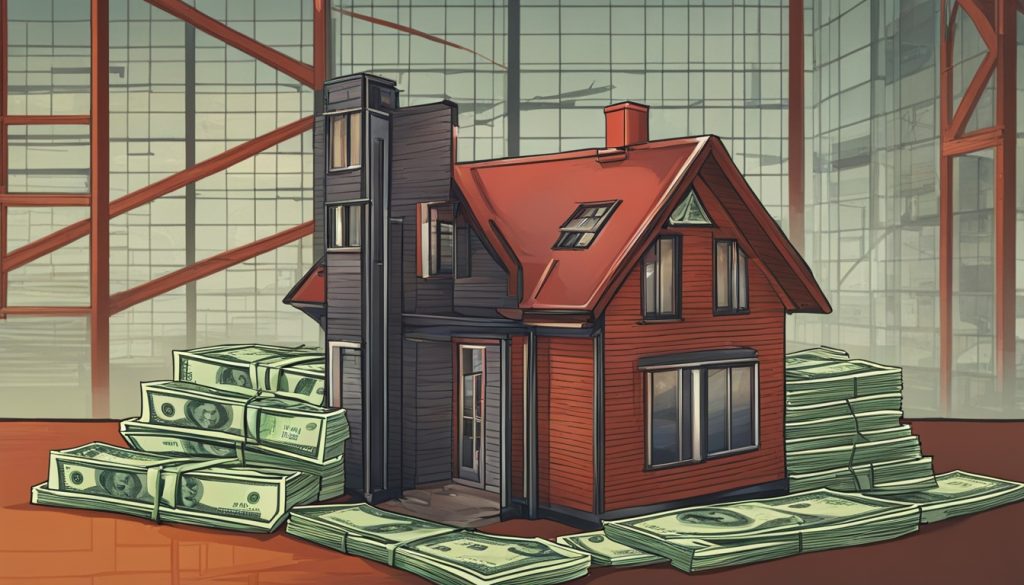Refinancing your mortgage can be a smart move if you want to lower your interest rate, cut your monthly payments, or use your home’s equity. It means swapping your current loan for a new one, similar to getting a mortgage for a new home. This process can save you thousands over the loan’s life12.
Recently, mortgage rates have gone up from their all-time lows. This makes refinancing a good choice for many homeowners1. If you can lower your interest rate by half to three-quarters of a point, refinancing is a good idea1. It can also help you get rid of private mortgage insurance (PMI) or switch to a shorter loan, which lowers your monthly payments2.
Key Takeaways
- Refinancing can help you lower your interest rate, reduce your monthly payments, or access your home’s equity.
- Mortgage rates have increased from historic lows, making refinancing more attractive for many homeowners.
- Aim to shave off at least one-half to three-quarters of a percentage point on your interest rate to make refinancing worthwhile.
- Closing costs for a refinance typically range from 2% to 6% of the loan amount.
- Comparing multiple mortgage offers can help you save thousands on your refinance.
Understand the Mortgage Refinancing Process
What is a Mortgage Refinance?
Mortgage refinancing means getting a new loan to replace your current one. It involves steps like a credit check and financial documents, similar to when you bought your home3. But, some refinance options like the FHA streamline or VA IRRRL are faster3. People usually refinance to get a lower interest rate, lower monthly payments, or to use their home’s equity3.
Refinancing usually takes about 30 to 45 days from start to finish3. You’ll need a credit score of 620 or higher for a conventional refinance3. A cash-out refinance lets you take money from your home’s value, which might increase your debt3. To skip upfront closing costs, you might choose a no-closing-cost refinance, adding the costs to your loan3.
Short refinancing helps homeowners at risk of losing their home, by reducing the loan amount3. For those 62 or older, reverse mortgages let you get cash from your home’s value and get monthly payments3. Debt consolidation refinances help pay off other debts with your home’s equity3. Streamline refinances are quicker, skipping some steps, for certain loans3.
Closing costs for refinancing can be 2% to 5% of your loan, covering fees and appraisals3. Before refinancing, think about your credit score, home equity, and goals to see if it’s a good idea3.
“80% of borrowers tend to refinance when interest rates fall.”4
Refinancing can lead to lower payments, shorter loan terms, or tapping into your home’s value3. Weigh the benefits of lower rates, consolidating debt, and avoiding extra down payments against the downsides like longer loans and higher costs3. It’s important to consider how it might affect your credit score and property taxes, looking at your specific situation3.
Reasons to Refinance Your Mortgage
Refinancing your mortgage can help you reach your financial goals. A key reason is to lower your interest rate and cut your monthly payments5. It also lets you switch from an adjustable-rate to a fixed-rate loan, making your payments more stable5.
With a lot of home equity, refinancing can eliminate private mortgage insurance (PMI), saving you money every month5. For FHA loans, refinancing can stop Mortgage Insurance Premium (MIP) payments after 11 years if your down payment was 10% or more5.
Shortening your loan term is another reason to refinance. Switching to a 15-year or 20-year mortgage can help you pay off your home faster and save on interest5. You can also use a cash-out refinance for home improvements, debt consolidation, or other goals5.
Refinancing is a smart move that can lower your payments and help you meet your financial goals5. Whether you want to save money, tap into your equity, or change your loan terms, exploring options with mortgage refinance companies5 is a good idea.

The refinancing process usually takes 38 to 48 days for a conventional mortgage6. FHA or VA-backed loans might take a week longer6. If you have a credit score of 750 or higher, you’re more likely to get the best rates and terms for cash-out refinancing6.
Refinancing can be a great financial tool, but make sure to think about your goals, costs, and timing carefully56.
mortgage refinancing, lower interest rates, home loan refinance
When mortgage rates drop below your current home loan rate, refinancing can save you money. By getting a new loan at a lower rate, you could lower your monthly payments. This frees up money in your budget7.
A $100,000, 30-year mortgage at 7% costs $665 a month. But at 5%, it drops to $5367. You could use this savings to pay off your mortgage faster or have more money each month.
But remember, refinancing comes with closing costs. These can be 3% to 6% of your loan’s value7. Make sure the savings are enough to cover these costs. Aim for at least a 1% rate drop to make it worth it7.
Refinancing to a 15-year mortgage can save you even more7. You could save $91 a month with a lower rate. You can also use a cash-out refinance to pay off debt or buy something big7.
Remember, the interest on your home loan might be tax-deductible7. Married couples filing together can deduct up to $750,000 in interest. Single people can deduct up to $375,0007. Mortgage points might be deductible too, unless they’re for home improvements7. Cash from refinancing isn’t taxed by the IRS7.
It’s important to compare rates from different lenders when refinancing8. The average 30-year refinance rate is 6.91%, and the 15-year rate is 6.50% as of July 17, 20248. Shopping around helps you find the best rate and terms for your refinance8.

Refinancing can help you save money, pay off your home faster, or tap into your equity. But, think about the costs and make sure the benefits last over time. By understanding the process and choosing the right lender, you can save a lot and make refinancing work for you78.
Prepare for the Refinancing Process
Check Your Credit Score and Home Equity
Before you start the refinance process, check your financial health. Look closely at your credit score. It greatly affects the refinance mortgage rates you can get. Try to have a credit score of at least 620 for conventional mortgage refinancing9.
Some government programs might accept scores as low as 580 or have no minimum10.
Also, find out your home’s market value and how much equity you have. Equity is what you own above your mortgage balance. Having 20% equity can save you from paying private mortgage insurance (PMI) and might get you better refinance mortgage calculator rates10.
Recently, U.S. homeowners saw their equity go up by 7.3% in a year, adding $1 trillion in total equity. On average, each homeowner gained $14,30010.
Reviewing your credit score and home equity gets you ready for refinancing. It helps you find the best deals for your money situation.

“Refinancing a mortgage usually costs between 3% and 6% of the total loan amount, with the average cost for a refinance of a mortgage on a single-family home being $3,860 in 2021.”10
Shop Around for the Best Rates
When refinancing your mortgage, it’s important to compare offers from different lenders. This way, you can find the best rates and terms. Right now, the average refinance interest rates are: 30-Year Fixed at 7.41% APR, 15-Year Fixed at 6.57% APR, and 30-Year Jumbo at 7.32% APR11. But, rates can change a lot between lenders, so get quotes from three to five providers.
Don’t forget to look at lender fees and closing costs too. These can add up and affect your refinance’s total cost. You might pay an application fee ($0-$500), attorney fees ($500-$1,000), and other costs like home appraisal ($300-$700) and origination fees (0.5%-2%)11.
Some top lenders offer great refinance rates:12
| Lender | Refinance Rate |
|---|---|
| JPMorgan Chase Bank | 3.40% |
| Wells Fargo Bank | 4.81% |
| State Employees’ Credit Union (SECU) | 5.78% |
| PennymacLoan Services | 5.84% |
| loanDepot | 5.95% |
Remember, refinance rates change every day, so get all your quotes on the same day for a fair comparison11. Your credit score, loan-to-value ratio, and the lender you pick can affect the rates11.
By comparing offers, you’ll find the best mortgage refinance lenders and refinance closing costs for your needs1112.
Gather Required Documentation
When you apply for a mortgage refinance, you’ll need to provide similar documents as when you got your first home loan13. You’ll need recent pay stubs, W-2s or tax returns, bank statements, and your current mortgage statement14. Sometimes, you might also need a home appraisal to figure out your property’s value and proof of homeowner’s insurance.
Getting these documents ready early can make the refinance process smoother14. Lenders want to see pay stubs from the last 30 days to check your income14. If you’re self-employed, they might ask for your last two tax returns and profit-and-loss statements14. They also need to know about your debts and expenses to figure out your debt-to-income ratio. Plus, they want to make sure you have the right homeowners insurance.
Paperwork for the Refinance Application
- Recent pay stubs
- W-2s or tax returns from the past two years
- Bank statements
- Current mortgage statement
- Home appraisal documentation
- Proof of homeowner’s insurance
Homeowners are also asked to provide statements from checking/savings accounts, retirement accounts, and investment accounts14. If you’ve had bankruptcy, credit issues, or gaps in your job history, you might need extra documents14. Having all your paperwork ready can make applying for a refinance smoother and faster.
| Document | Purpose |
|---|---|
| Pay stubs | Verify current income |
| Tax returns | Confirm past income and employment history |
| Bank statements | Demonstrate financial stability and assets |
| Mortgage statement | Provide details on your current loan |
| Home appraisal | Determine your property’s current market value |
| Homeowner’s insurance | Ensure adequate coverage for the property |
Getting your documents ready early can help make the refinance application process easier and improve your chances of getting good refinance mortgage rates1314.
Understand the Closing Process
The closing process for a refinance is similar to when you bought your home. Your lender will give you a closing disclosure three business days before the closing date. This document outlines the loan’s final terms and refinance closing costs15. Make sure to check it over carefully.
At closing, you’ll sign papers to complete the refinance and pay any costs. You can pay these costs upfront or add them to the new loan15. These costs can include title insurance, escrow fees, and more, adding up to 2% – 6% of the loan15. Closing a refinance usually takes about half an hour, unlike buying a home which takes longer15.
After closing, your old mortgage is paid off, and your new loan starts. Refinancing can help you pay off your mortgage faster, lower your monthly payments, or own your home sooner16. While it may take time, refinancing can save you money over the years with lower interest rates and payments15.
A cash-out refinance lets you use your refinance home equity for cash and better rates15. The Truth in Lending Act gives you three business days to change your mind or ask for changes after signing15.
| Metric | Value |
|---|---|
| Typical Closing Costs | 2% – 6% of Total Mortgage Loan15 |
| Average Refinance Closing Time | 30 – 45 Days15 |
| Signing Time | About 30 Minutes15 |
| Average Savings | $300 per Year on Mortgage Payments16 |
Understanding the closing timeline and costs is key to a smooth refinance. By looking over the closing disclosure and being ready for signing, you can make a smart choice. This way, you can enjoy the benefits of refinancing1516.
Conclusion
Refinancing your mortgage can be a smart move that helps you save money and use your home’s value. It lets you lower your interest rates17 and use your home’s equity17. By learning about refinancing, getting your finances ready, and comparing rates, you can decide if it’s right for you18.
Think about your future plans, how much you’ll save each month, and the costs of getting a new mortgage17. Make sure the benefits of refinancing are worth the upfront costs1817.
If you want lower interest rates17, to use your home’s equity, or to change your loan terms, look into mortgage refinancing, lower interest rates, and home loan refinance options. This can help you reach your financial goals1817.
Source Links
- How To Get The Best Refinance Rate | Bankrate
- Articles
- Mortgage Refinancing: What Is It And How Does It Work? | Bankrate
- Refinance: What It Is, How It Works, Types, and Example
- Why Do You Refinance A House? 5 Reasons To Refinance Your Home Loan | Quicken Loans
- When Should You Refinance a Home?
- When to Refinance Your Mortgage
- Current Refinance Rates – Compare Rates Today | Bankrate
- How to Refinance Your Mortgage – NerdWallet
- 9 Things to Know Before You Refinance Your Mortgage
- Compare Current Mortgage Refinance Rates
- Find the Best Refinance Rates in 2024 | Compare Top Lenders
- Documents are Needed for Refinance
- What Documents Do You Need To Refinance A Mortgage? | Quicken Loans
- Refinance Closing: An Overview | Quicken Loans
- 6 Steps Of The Mortgage Refinance Process | Timeline To Close
- When Should You Refinance Your Mortgage? | Bankrate
- The pros and cons of refinancing your home

